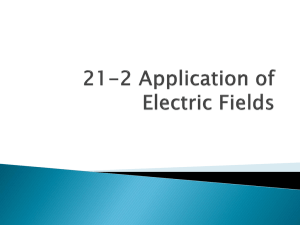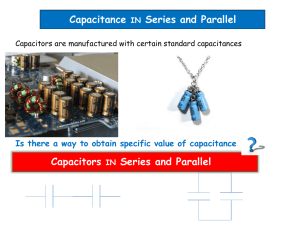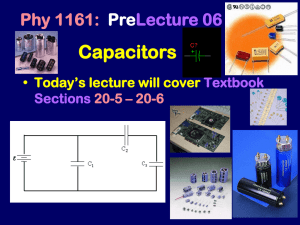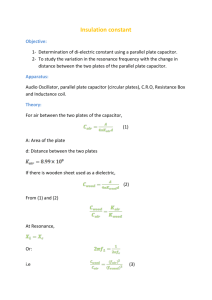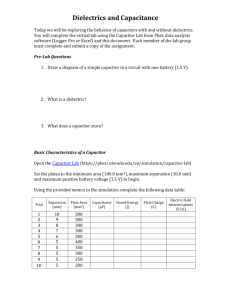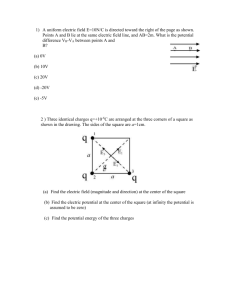Solutions_P12
advertisement
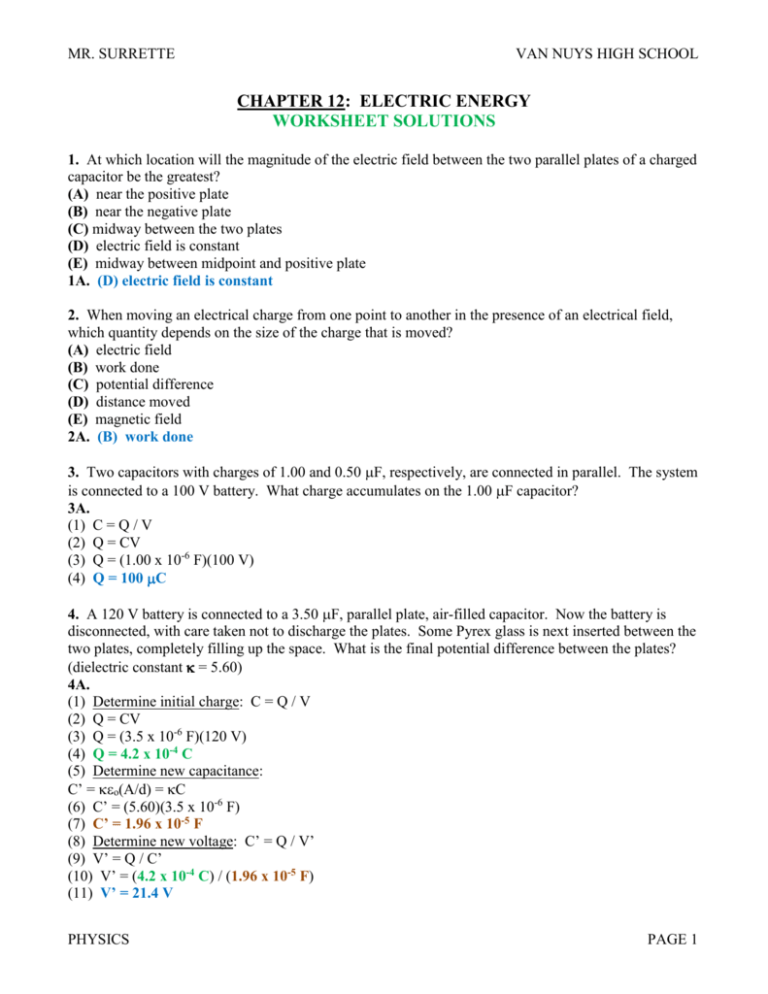
MR. SURRETTE VAN NUYS HIGH SCHOOL CHAPTER 12: ELECTRIC ENERGY WORKSHEET SOLUTIONS 1. At which location will the magnitude of the electric field between the two parallel plates of a charged capacitor be the greatest? (A) near the positive plate (B) near the negative plate (C) midway between the two plates (D) electric field is constant (E) midway between midpoint and positive plate 1A. (D) electric field is constant 2. When moving an electrical charge from one point to another in the presence of an electrical field, which quantity depends on the size of the charge that is moved? (A) electric field (B) work done (C) potential difference (D) distance moved (E) magnetic field 2A. (B) work done 3. Two capacitors with charges of 1.00 and 0.50 F, respectively, are connected in parallel. The system is connected to a 100 V battery. What charge accumulates on the 1.00 F capacitor? 3A. (1) C = Q / V (2) Q = CV (3) Q = (1.00 x 10-6 F)(100 V) (4) Q = 100 C 4. A 120 V battery is connected to a 3.50 F, parallel plate, air-filled capacitor. Now the battery is disconnected, with care taken not to discharge the plates. Some Pyrex glass is next inserted between the two plates, completely filling up the space. What is the final potential difference between the plates? (dielectric constant = 5.60) 4A. (1) Determine initial charge: C = Q / V (2) Q = CV (3) Q = (3.5 x 10-6 F)(120 V) (4) Q = 4.2 x 10-4 C (5) Determine new capacitance: C’ = o(A/d) = C (6) C’ = (5.60)(3.5 x 10-6 F) (7) C’ = 1.96 x 10-5 F (8) Determine new voltage: C’ = Q / V’ (9) V’ = Q / C’ (10) V’ = (4.2 x 10-4 C) / (1.96 x 10-5 F) (11) V’ = 21.4 V PHYSICS PAGE 1 MR. SURRETTE VAN NUYS HIGH SCHOOL 5. A parallel plate capacitor has dimensions 3.5 cm x 2.5 cm. The plates are separated by a 1.0 mm thickness of paper (dielectric constant = 3.7). What is the charge that can be stored on this capacitor, when connected to a 12 volt battery? 5A. (1) C = o(A / d) (2) A = (2.5 x 10-2 m)(3.5 x 10-2 m) (3) A = 8.75 x 10-4 m2 (4) C = (3.70)(8.85 x 10-12)(8.75 x 10-4 m2 / 1.00 x 10-3 m) (5) C = 2.87 x 10-11 F (6) C = Q / V (7) Q = CV (8) Q = (2.87 x 10-11 F)(12 V) (9) Q = 3.44 x 10-10 C 6. Very large capacitors have been considered as a means for storing electrical energy. If we constructed a very large parallel plate capacitor of plate area 3.25 m2 using pyrex ( = 5.60) of thickness 1.75 mm as a dielectric, how much electrical energy would it store at a plate voltage of 7000 V? 6A. (1) Determine the capacitance: C = o(A / d) (2) C = (5.60) (8.85 x 10-12)(3.25 m2 / 1.75 x 10-3 m) (3) C = 9.2 x 10-8 F (4) Determine electrical energy: U = ½ CV2 (5) U = ½ (9.2 x 10-8 F)(7000 V)2 (6) U = 2.25 J 7. There is a hollow, conducting, uncharged sphere with a charge +Q inside the sphere. Consider the potential and the electrical field at a point P1 inside the metal of the sphere. At this point: 7A. (A) only the electrical field is zero. 8. What is the equivalent capacitance of the combination shown? PHYSICS PAGE 2 MR. SURRETTE VAN NUYS HIGH SCHOOL 8A. (1) Left side: CL = 10 F + 20 F (2) CL = 30 F (3) Right side: CR = 30 F + 30 F (4) CR = 60 F (5) Both sides: 1 / Ceq = (1 / CL) + (1 / CR) (6) 1 / Ceq = 1/30 F + 1/60 F (7) 1 / Ceq = 3/60 F = 1/20 F (8) Ceq = 20 F 9. Inserting a dielectric material between two charged parallel conducting plates, originally separated by air and disconnected from a battery, will produce what effect on the capacitor? 9A. (C) increase capacitance 10. A uniform electric field, with a magnitude of 5 x 102 N/C, is directed parallel to the positive x-axis. If the potential at x = 5.00 m is 2500 V, what is the potential at x = 2.00 m? 10A. 1000 V. Since the electric field is constant throughout, V is proportional to d. Since x at 5.00 m is equal to 2500 V, this means 500 V per meter. 11. A parallel plate capacitor is charged by a battery. The plate area is 15 cm x 250 cm, the gap between plates is 0.35 mm, and the battery voltage is 30 V. 11a. Calculate the capacitance in nanofarads assuming vacuum between the plates. A. (1) C = o(A/d) (2) A = (L)(w) (3) A = (0.15 m)(2.5 m) (4) A = 0.375 m2 (5) C = (8.85 x 10-12)[(0.375 m2) / (3.5 x 10-4 m) (6) C = 9.48 x 10-9 F = 9.48 nF 11b. Calculate the charge Q on the plates in nanocoulombs. A. (1) C = Q / V (2) Q = CV (3) Q = (9.48 x 10-9 F)(30 V) (4) Q = 2.84 x 10-7 C (5) Q = 284 nC PHYSICS PAGE 3 MR. SURRETTE VAN NUYS HIGH SCHOOL 11c. Evaluate the stored energy in microjoules. A. (1) U = ½ CV2 (2) U = ½ (9.48 x 10-9 F)(30 V)2 (3) U = 4.27 J 12. Now fill the region between the plates with material of dielectric constant 3.0 while maintaining 30 V across the plates by keeping them connected to the battery. 12a. Calculate the capacitance in nanofarads. A. (1) C = o(A / d) (2) A = (L)(w) (3) A = (0.15 m)(2.5 m) (4) A = 0.375 m2 (5) C = (3)(8.85 x 10-12)[(0.375 m2) / (3.5 x 10-4 m)] (6) C = 2.84 x 10-8 F = 28.4 nF 12b. Calculate the charge Q on the plates in nanocoulombs. A. (1) C = Q / V (2) Q = CV (3) Q = (28.4 x 10-9 F)(30 V) (4) Q = 8.52 x 10-7 C (5) Q = 852 nC 12c. Evaluate the stored energy in microjoules. A. (1) Uc = ½ CV2 (2) Uc = ½ (28.4 x 10-9 F)(30 V)2 (3) Uc = 1.29 x 10-5 J (4) Uc = 12.9 J 13. Two capacitors are connected in parallel. 13a. What is the voltage and charge for the 2 microfarad capacitor? A. (1) Voltage remains constant at 10 V. (2) C = Q / V (3) Q = CV (4) Q = (2 F)(10 V) (5) Q = 20 C PHYSICS PAGE 4 MR. SURRETTE VAN NUYS HIGH SCHOOL 13b. What is the voltage and charge for the 4 microfarad capacitor? (1) Voltage is constant at 10 V. (2) C = Q / V (3) Q = CV (4) Q = (4 F)(10 V) (5) Q = 40 C 13c. What is the total charge stored? (1) Q = Q1 + Q2 (2) Q = 20 C + 40 C (3) Q = 60 C 13d. Determine the equivalent capacitance of the combination in microfarads. (1) Ceq = C1 + C2 (2) Ceq = 2 F + 4 F (3) Ceq = 6 F 14. Two capacitors are connected in series. 14a. What is the equivalent capacitance in microfarads? A. (1) 1 / Ceq = 1 / C1 + 1 / C2 (2) 1 / Ceq = 1 / (3 F) + 1 / (6 F) (3) 1 / Ceq = 2 / (6 F) + 1 / (6 F) (4) 1 / Ceq = 3 / (6 F) (5) 1 / Ceq = 1 / (2 F) (6) Ceq = 2 F 14b. Determine the charge on the 3 microfarad capacitor in microcoulombs. A. (1) Ceq = Q1 / V (2) Q1 = (Ceq)(V) (3) Q1 = (2 F)(10 V) (4) Q1 = 20 C PHYSICS PAGE 5 MR. SURRETTE VAN NUYS HIGH SCHOOL 14c. Calculate the voltage across the 3 microfarad capacitor. A. (1) C1 = Q1 / V1 (2) V1C1 = Q1 (3) V1 = Q1 / C1 (4) V1 = 20 C / 3 F (5) V1 = 6.7 V 14d. Calculate the voltage across the 6 microfarad capacitor. A. (1) C2 = Q2 / V2 (2) V2C2 = Q2 (3) V2 = Q2 / C2 (4) V2 = 20 C / 6 F (5) V2 = 3.3 V PHYSICS PAGE 6 MR. SURRETTE VAN NUYS HIGH SCHOOL CHAPTERS 11 - 12: ELECTRIC FORCES and ENERGY QUIZ SOLUTIONS 1. Two point charges are placed along a horizontal axis with the following values and positions: +4 C at x = 0 cm and -9 C at x = 20 cm. What is the magnitude of the electric field at the point midway between the two charges (at x = 10 cm)? 1A. (1) E = E1 + E2 (2) E1 = kq1 / r2 (3) E1 = (9.0 x 109 N.m2/C2)(4 x 10-6 C) / (0.10 m)2 (4) E1 = 3.60 x 106 N/C (5) E2 = kq2 / r2 (6) E2 = (9.0 x 109 N.m2/C2)(9 x 10-6 C) / (0.10 m)2 (7) E2 = 8.10 x 106 N/C (8) E = 3.60 x 106 N/C + 8.10 x 106 N/C (9) E = 1.17 x 107 N/C 2. Initially, a net charge of – 11.0 C is placed on a 5.0 cm radius metallic hollow sphere. Next, a +10 C charge is carefully inserted at the center through a hole in the latter’s surface. What electric field is present at a point 20 cm from the center of the sphere? 2A. (1) E = k(QEFF) / r2 (2) QEFF = 10 C – 11 C (3) QEFF = - 1 C (4) E = (9.00 x 109 N.m2/C2)(1 x 10-6 C) / (0.2 m)2 (5) E = 2.25 x 105 N/C 3. A Van De Graaff generator has a spherical dome of radius 50 cm. Operating in dry air, where “atmospheric breakdown” is Emax = 3.00 x 106 N/C what is the maximum charge that can be held on the dome? 3A. (1) E = kq / r2 (2) q = Er2 / k (3) q = (3.00 x 106 N/C)(0.50 m)2 / (9.0 x 109 N.m2/C2) (4) q = 8.34 x 10-5 C 4. A glass rod rubbed with a silk cloth acquires a charge of + 8.49 x 10-8 C. How many electrons were transferred from the glass to the silk? 4A. (8.49 x 10-8 C)(1 electron / 1.6 x 10-19 C) = 5.31 x 1011 electrons PHYSICS PAGE 7 MR. SURRETTE VAN NUYS HIGH SCHOOL 5. A positive point charge is brought near a grounded conductor. Sketch the induced charge on the conductor’s surface: 5A. The positive charge attracts electrons from ground to the sphere’s surface – the closer the charge is to the sphere the more negative it becomes: 6. What happens to the charge on the sphere when the positive charge is removed? 6A. It runs back to ground through the wire joining it to the earth. A charged conductor is made neutral by grounding it. 7. Three point charges are on an x-axis. Charge Q1 on the left is +20 C. Charge Q3 on the right is -30 C. They are 1.2 meters apart. Charge Q2 is midway between them. Calculate the net electric force on Q2 if it has a +15 C charge. 7A. (1) Force from left: F = kQ1Q2/r2 (2) (9.0 x 109 N.m2/C2)(20 x 10-6 C)(15 x 10-6 C) / (0.6 m)2 (3) F = 7.5 N (to the right) (4) Force from right: F = kQ1Q2/r2 (5) (9.0 x 109 N.m2/C2)(30 x 10-6 C)(15 x 10-6 C) / (0.6 m)2 (6) F = 11.25 N (to the right) (7) F = 18.75 N (to the right) PHYSICS PAGE 8 MR. SURRETTE VAN NUYS HIGH SCHOOL 8. A parallel plate capacitor is charged by a battery. The plate area is 15 cm x 315 cm, the gap between plates is 1.70 mm, and the battery voltage is 30 V. 8a. A. (1) (2) (3) (4) (5) (6) 8b. A. (1) (2) (3) Calculate the capacitance in nanofarads assuming vacuum between the plates. C = o(A/d) A = (L)(w) A = (0.15 m)(3.15 m) A = 0.47 m2 C = (8.85 x 10-12)[(0.47 m2) / (1.70 x 10-3 m)] C = 2.46 x 10-9 F = 2.5 nF Evaluate the stored energy in microjoules. U = ½ CV2 U = ½ (2.46 x 10-9 F)(30 V)2 U = 1.11 x 10-6 J = 1.1 J Now fill the region between the plates with material of dielectric constant 4.7 while maintaining 30 V across the plates by keeping them connected to the battery. 8c. Calculate the capacitance in nanofarads. A. (1) C’ = o(A/d) (2) C’ = C (3) C’ = (4.7)(2.46 nF) (4) C’ = 11.6 nF 8d. A. (1) (2) (3) (4) Calculate the charge Q on the plates in nanocoulombs. C=Q/V Q = CV Q = (11.6 x 10-9 F)(30 V) Q = 3.48 x 10-7 C = 348 nC PHYSICS PAGE 9 MR. SURRETTE VAN NUYS HIGH SCHOOL 9. Two capacitors are connected in series. What is the equivalent capacitance in microfarads? 9A. (1) 1 / Ceq = 1 / C1 + 1 / C2 (2) 1 / Ceq = 1 / (3 F) + 1 / (6 F) (3) 1 / Ceq = 2 / (6 F) + 1 / (6 F) (4) 1 / Ceq = 3 / (6 F) (5) 1 / Ceq = 1 / (2 F) (6) Ceq = 2 F 10. A 175 V battery is connected to a 1.15 F, parallel plate, air-filled capacitor. Now the battery is disconnected, with care taken not to discharge the plates. Some Pyrex glass is next inserted between the two plates, completely filling up the space. What is the final potential difference between the plates? (dielectric constant = 5.60) 10A. (1) Determine initial charge: C = Q / V (2) Q = CV (3) Q = (1.15 x 10-6 F)(175 V) (4) Q = 2.01 x 10-4 C (5) Determine new capacitance: C’ = o(A/d) = C (6) C’ = (5.60)(1.15 x 10-6 F) (7) C’ = 6.44 x 10-6 F (8) Determine new voltage: C’ = Q / V’ (9) V’ = Q / C’ (10) V’ = (2.01 x 10-4 C) / 6.44 x 10-6 F) (11) V’ = 31.3 V 11. A parallel plate capacitor has dimensions 4.52 cm x 3.15 cm. The plates are separated by a 1.00 mm thickness of paper (dielectric constant = 3.70). What is the charge that can be stored on this capacitor, when connected to a 12.0 volt battery? PHYSICS 10 PAGE MR. SURRETTE VAN NUYS HIGH SCHOOL 11A. (1) C = o(A / d) (2) A = (4.52 x 10-2 m)(3.15 x 10-2 m) (3) A = 1.42 x 10-3 m2 (4) C = (3.70)(8.85 x 10-12)(1.42 x 10-3 m2 / 1.00 x 10-3 m) (5) C = 4.65 x 10-11 F (6) C = Q / V (7) Q = CV (8) Q = (4.65 x 10-11 F)(12.0 V) (9) Q = 5.6 x 10-10 C 12. Very large capacitors have been considered as a means for storing electrical energy. If we constructed a very large parallel plate capacitor of plate area 5.12 m2 using pyrex ( = 5.60) of thickness 1.14 mm as a dielectric, how much electrical energy would it store at a plate voltage of 16,000 V? 12A. (1) Determine the capacitance: C = o(A / d) (2) C = (5.60)(8.85 x 10-12 C2/N.m2)(5.12 m2 / 1.14 x 10-3 m) (3) C = 2.23 x 10-7 F (4) Determine the electrical energy: U = ½CV2 (5) U = ½(2.23 x 10-7 F)(16,000 V)2 (6) U = 28.5 J PHYSICS 11 PAGE
